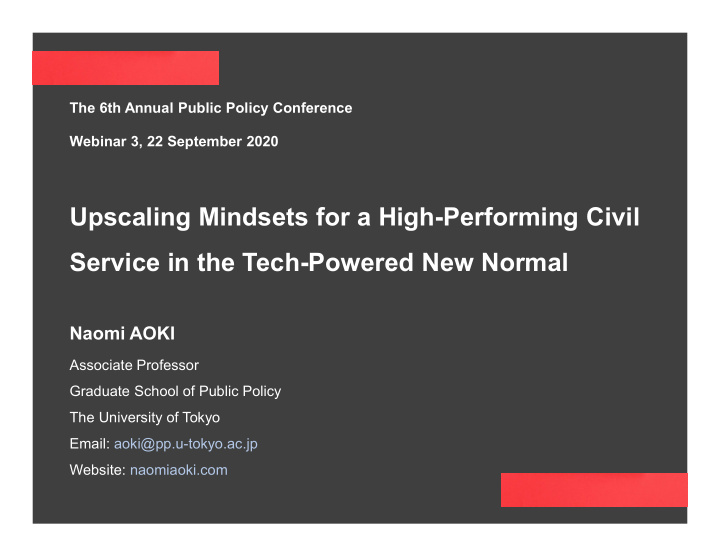



The 6th Annual Public Policy Conference Webinar 3, 22 September 2020 Upscaling Mindsets for a High-Performing Civil Service in the Tech-Powered New Normal Naomi AOKI Associate Professor Graduate School of Public Policy The University of Tokyo Email: aoki@pp.u-tokyo.ac.jp Website: naomiaoki.com
The Tech-Powered New Normal A condition of atypical situations that have become ordinary in the wake of the COVID-19 crisis and the resulting changes powered by an extensive use of technologies. Image by Anastasia Gepp from Pixabay.
Uses of technology in the battle against the pandemic: Examples Image by Anastasia Gepp from Pixabay
Contact tracing apps Image by Markus Winkler from Pixabay.
Mask purchase regulating system Image by Markus Winkler from Pixabay.
Telemedicine Image by Gerd Altmann from Pixabay.
Chatbots Image by mohamed Hassan from Pixabay.
Robot for virus testing Callesen, J. T. (2020), available at the World Economic Forum website: https://www.weforum. org/agenda/2020/06/f irst-swab-robot-can- teach-about-fast- innovation-covid-19/
Online and digital schooling Image by Mudassar Iqbal from Pixabay.
Telework Image by cromaconceptovisual from Pixabay.
Upscaling four mindsets for a high- performing civil service Image by Anastasia Gepp from Pixabay
1 2 1 Be open to open Be mindful of design innovation innovation thinking and user orientation 3 4 Attend to public trust Care for the digitally in technologies disadvantaged innovation
1 Be open to open innovation Open Innovation is “a distributed innovation process based on purposively managed knowledge flows across organizational boundaries, using pecuniary and non-pecuniary mechanisms in line with each organization's business model” (p. 27). Chesbrough, H., & Bogers, M. (2014). Explicating open innovation: Clarifying an emerging paradigm for understanding innovation. In H. Chesbrough, W. Vanhaverbeke, & J. West (Eds.), New frontiers in open innovation (pp. 3–28). Oxford: Oxford University Press.
1 Be open to open innovation Example 1: World Food Programme Innovation Challenge 2020 “WFP seeks cutting-edge solutions to transform emergency response and to achieve SDG2: Zero Hunger by 2030 for communities impacted by COVID19 and beyond. Innovations are needed more than ever before to achieve this goal.” World Food Programme. (2020). Apply to the WFP Innovation Accelerator. https://innovation.wfp.org/apply
1 Be open to open innovation Example 2: Taiwan’s open data Taiwanese authorities made available real-time data on face-mask inventories in authorized stores and health centres, such that online civic and tech communities can use the data to develop software applications that indicate where masks are available for purchase. Yuan, E. J., Hsu, C., Lee, W., Chen, T., Chou, L., & Hwang, S. (2020). Where to buy face masks? Survey of applications using Taiwan’s open data in the time of coronavirus disease 2019 . Journal of the Chinese Medical Association, 83 (6), 557-560. doi: 10.1097/JCMA.0000000000000325
1 Be open to open innovation Barriers to open innovation (OI) “The organizational culture factors include several different aspects of the OI process: (a) type of agency and political context, (b) acceptance of external innovations, and (c) the lack of top-management support and buy-in” (p. 737). Mergel, I. (2018). Open innovation in the public sector: Drivers and barriers for the adoption of Challenge.gov. Public Management Review , 20 (5), 726-745. https://doi.org/10.1080/14719037.2017.1320044
2 Be mindful of design thinking and user orientation User-oriented thinking can help civil servants to identify a technological solution. Image by Klaus Aires Alves from Pixabay.
2 Be mindful of design thinking and user orientation Design Thinking “can mean different things, but it usually describes processes, methods, and tools for creating human- centered products, services, solutions, and experiences. It involves establishing a personal connection with the people--or users--for whom a solution is being developed” (p. 86). Bason, C., & Austin, R. D. (2019). The right way to lead design thinking. Harvard Business Review , March-April Issue, 82-91. https://hbr.org/2019/03/the-right-way-to-lead-design-thinking
3 Attend to public trust in technologies Machines need to be as trustworthy as the humans who deliver public services because it is important for the public to be able to trust public services, whether or not they are provided by machines, and because people will not use machines if they do not trust them.
3 Attend to public trust in technologies Does the public trust chatbots when they hear that the government is about to introduce “AI” chatbots to respond to their inquiries? Image by mohamed Hassan from Pixabay Aoki, N. (2020). An experimental study of public trust in AI chatbots in the public sector. Government Information Quarterly, 37 (4), 101490. https://doi.org/10.1016/j.giq.2020.101490
3 Attend to public trust in technologies Note. Table from the preprint version.
3 Attend to public trust in technologies Findings • The public's initial trust in chatbots depends on the area of enquiry. • Certain purposes communicated by governments would slightly enhance the public’s initial trust. Aoki, N. (2020). An experimental study of public trust in AI chatbots in the public sector. Government Information Quarterly, 37 (4), 101490. https://doi.org/10.1016/j.giq.2020.101490
4 Care for the digitally disadvantaged “Digital inequalities are putting socially and economically disadvantaged people at more risk to the virus” (p. 1). Beaunoyer, E., Dupéré, S., & Guitton, M. (2020). COVID-19 and digital inequalities: Reciprocal impacts and mitigation strategies. Computers in Human Behavior, 111, 106424. https://doi.org/10.1016/j.chb.2020.106424
4 Care for the digitally disadvantaged eHealth literacy is the "ability to seek, find, understand, and appraise health information from electronic sources and apply the knowledge gained to addressing or solving a health problem.” Norman, C. D., & Skinner, H. A. (2006). eHealth literacy: Essential skills for consumer health in a networked world. Journal of Medical Internet Research, 8 (2), e9. doi: 10.2196/jmir.8.2.e9
1 2 1 Be open to open Be mindful of design innovation innovation thinking and user orientation 3 4 Attend to public trust Care for the digitally in technologies disadvantaged innovation
Thank you. Image by Anastasia Gepp from Pixabay
Recommend
More recommend